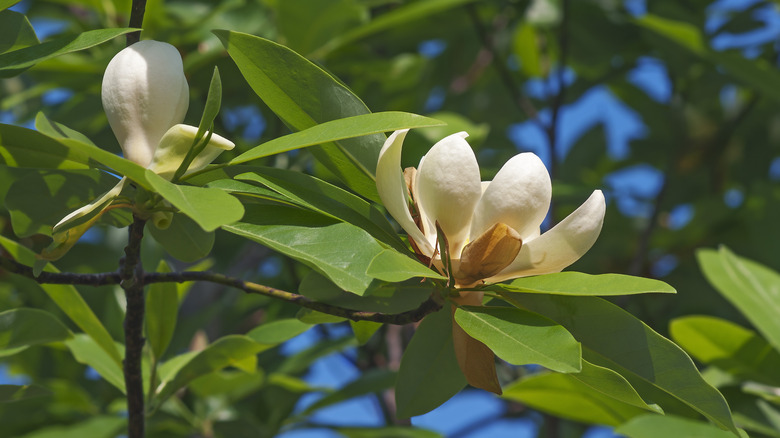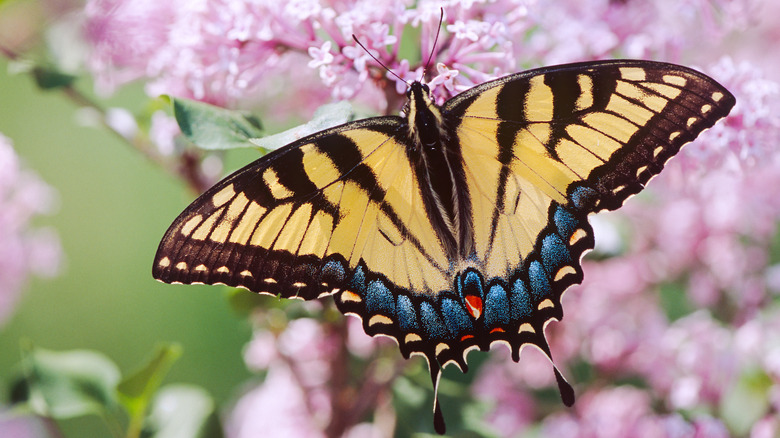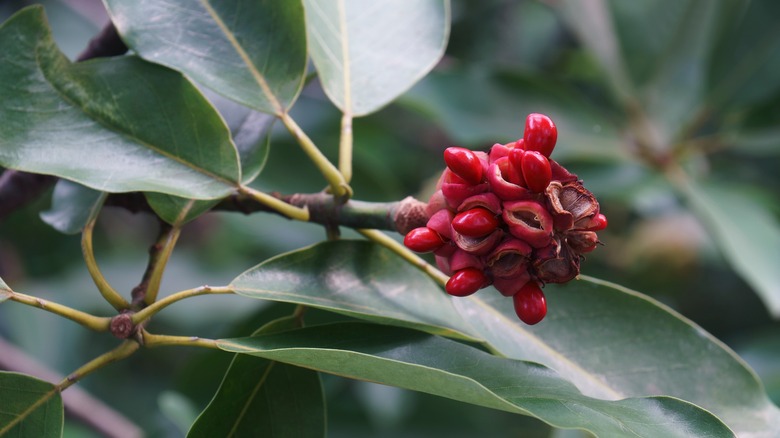Sweetbay Magnolia Trees Bring Butterflies And Other Benefits To Your Yard
Within the magnolia family tree, sweetbay magnolia (Magnolia virginiana) often gets overshadowed by southern magnolia (Magnolia grandiflora), its bigger and more famous cousin. While the southern magnolia earns accolades for its grand stature, vivid flowers, and glossy green leaves, the sweetbay magnolia deserves its own moment in the sun. Its flowers may be smaller than those of its renowned relative, but they are just as fragrant, producing a sweet, lemony scent. Sweetbay magnolia's shorter stature also makes it more versatile, especially in smaller landscapes. Plus, the trees are host plants for butterflies and moths.
Sweetbay magnolias are slender, semi-evergreen to evergreen trees or shrubs native to many of the eastern and midwestern regions of the United States. These graceful trees can reach heights of 10 to 35 feet, and their limbs are covered in smooth gray bark. Their oblong leaves are dark green above and silvery below. In late spring to mid-summer, the trees boast cream-colored white flowers, which give rise to clusters of conical fruit in the fall. The fruit's bright red seeds attract numerous songbirds and other wildlife. Best of all, it is easy to grow and care for sweetbay magnolia trees. With so many benefits, these upstaged trees deserve more attention.
Why butterflies are attracted to sweetbay magnolia trees
Sweetbay magnolias can attract butterflies to your garden, but not for the reason you might think. Magnolias are among the oldest flowering plants on earth. When they evolved nearly 100 million years ago, beetles — not bees or butterflies — were the primary pollinators. As a result, butterflies aren't that interested in sweetbay magnolia's flowers. But some species, including the much-loved eastern tiger swallowtail (Papilio glaucus), lay their eggs on the tree's leaves. Whether a plant serves as a host for butterfly broods depends on the plant's nutritional benefits and the larvae's resistance to the plant's chemical defenses. Fortunately, eastern tiger swallowtail caterpillars are immune to the sweetbay magnolia's chemical compounds.
In addition to swallowtails, sweetbay magnolias are the exclusive hosts for the sweetbay silkmoth (Callosamia securifera), a large, yellowish to orange-brown moth found in the southeast. Like swallowtail larvae, the silkmoth caterpillars are resistant to the sweetbay magnolia's chemical defenses. These moths may not get the same hype as their butterfly counterparts, but the adults are eye-catching.
Other benefits of sweetbay magnolia trees
Where there are caterpillars and seeds, there are bound to be birds, and that's certainly true for the sweetbay magnolia. While birds seem turned off by the swallowtail caterpillars' unpleasant taste, moth caterpillars are a protein-packed snack, especially during nesting season. Caterpillars contain lots of fat and protein; even predominantly seed-eating birds, like cardinals, feed them to their nestlings. Birds also flock to sweetbay magnolias in the late summer and fall to feast on their seeds. Tanagers, grosbeaks, cardinals, finches, vireos, blue jays, and even wild turkeys scarf up these tasty treats. Additionally, mockingbirds, robins, and eastern kingbirds often use the leaves and twigs of sweetbay magnolia to make their nests.
Another advantage of growing sweetbay magnolias is that these trees require little work. Although they grow well throughout zones 5 to 9, they appear more shrublike in the northern parts of their range. These beautiful flowering trees love damp soil and prefer full sun to part shade. Once they're established, they need little maintenance or pruning. These nontoxic, pet-safe trees produce natural antimicrobial and insecticidal compounds, making them less susceptible to pests and diseases. Sweetbay magnolias even grow well in containers. Several cultivated varieties of sweetbay magnolia are available, including some with larger flowers and increased cold tolerance. Regardless of which type you choose, these trees are worthy of taking center stage in your landscape.


